One of the challenges new gardeners face is how to determine how much sunlight an area gets. The best way to figure it out is to measure hours of sunlight in your garden, and create a garden sun chart. Don’t worry, it’s easy. In this post, I’m going to show you exactly how to determine the sun exposure in your garden.
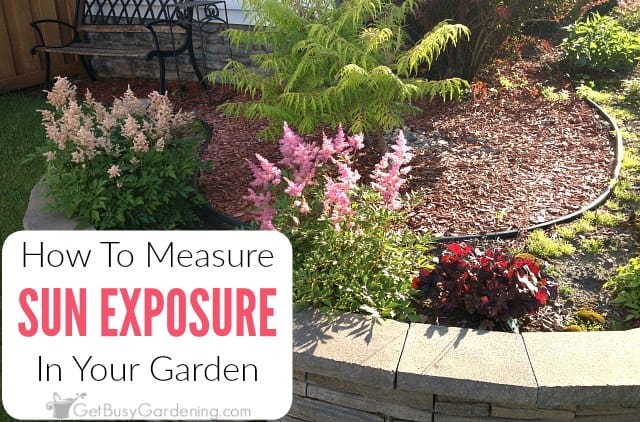
People ask me for plant recommendations all the time, it’s probably the most common questions I get from gardeners.
It seems like an easy question to answer, right? But there are tons of factors involved, and garden sun exposure is an important one.
So, my answer always starts with “that depends”, which is shortly followed by “how much sun does your garden get?”.
That question is usually followed by lots of other questions… How is the amount of sunlight measured? How many hours of sunlight is considered full sun? What does partial shade mean?
I know it can be frustrating, but I have great news for you! It’s super easy to measure sunlight exposure in your garden, and create you very own, custom garden sun chart, so let’s start with that first.
How To Determine Sun Exposure In Your Garden
If you haven’t figured out how many hours of sunlight your garden gets yet, or you haven’t done it in a while, it’s a good exercise.
You might be surprised to realize that your “full sun garden” is really a partial shade garden… or that your “shade garden” gets more sun than you thought (aha! no wonder those shade plants are burning!).
To measure hours of sunlight in your garden, start early in the morning right after the sun rises.
Take note of the garden sunlight exposure at that time. Then make a note of whether it’s in full sun, partial shade, filtered/dappled sun, or full shade.
Then every hour, check the garden area again and write down the garden sun exposure. Keep measuring garden sunlight in each area every hour until sunset.
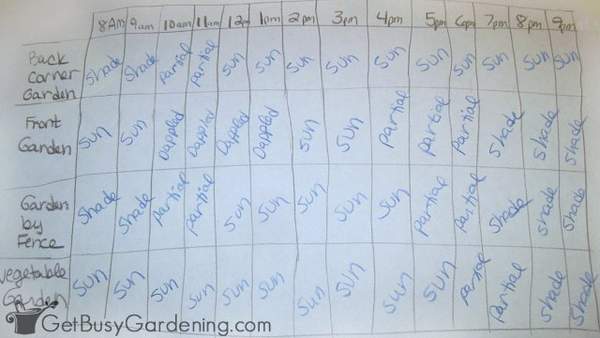
If it’s a large garden area, you might want to map sunlight exposure in the different sections of the garden as they come into the sun, or move into shade.
You could even take this onto a larger scale to determine the sun exposure of your entire backyard, front yard or the whole property, and track everything in one chart.
Related Post: Perennials vs Annuals: What’s The Difference?
If you don’t want to take the time to map the sunlight in your garden, then there are a few tools you could try instead. An inexpensive garden light meter is a nice little tool to have (also measures soil moisture and ph levels tool!).
Otherwise, you could use a time lapse camera as a sunlight meter and set it to take a photo of your garden every hour to make it super easy for you!
Buy Plants According To Your Garden Sun Exposure
Once you know how much sunlight an area gets, and at which hours during the day, it makes it super easy to buy plants for your garden!
All you have to do is read the plant tag on every plant before you buy it. The tag should tell you the plant sun exposure requirements, for example shade, partial shade, full sun, partial sun…
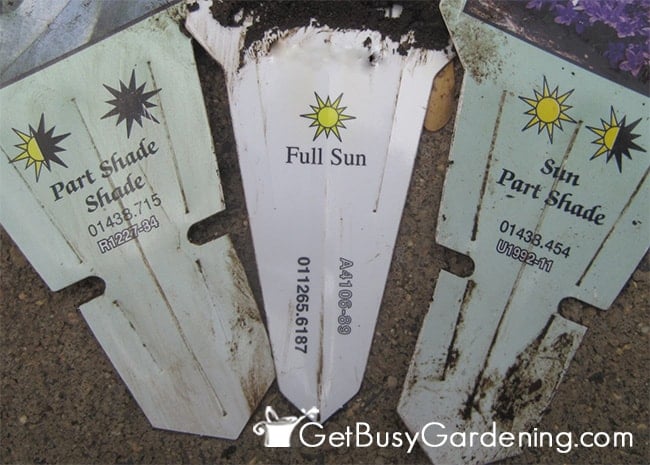
Plant Sun Exposure Requirements Defined
Sounds easy but… what does full sun mean? What is partial shade -vs- full shade? How many hours a day is full sun?
Don’t panic, I’ve got you covered! Here’s a breakdown of plant sun exposure requirements to make it super simple for you…
How Many Hours A Day Is Full Sun?
A full sun garden is an area that gets at least 6 hours of direct sunlight throughout the day. Full sun plants are easy to shop for, so lucky you!
How Many Hours Of Sun For Partial Sun?
Partial sun and partial shade are similar, and generally mean a garden that gets 3 to 6 hours of sunlight. A partial sun garden means the area gets closer to 6 hours of sunlight.
Many full sun plants, and even some partial shade plants can also grow just fine in a partial sun garden.
How Many Hours Of Sunlight Is Partial Shade?
In contrast to partial sun, a partial shade garden is an area that gets closer to 3 hours of sun, and is also protected from the intense afternoon sun.
Some part sun perennials grow fine in a partial shade garden, and some shade plants grow well in partial shade too.
However, if you notice your shade plants burning in the summer, then that means they’re getting too much sun and should be moved to your shade garden.
How Many Hours Of Sun Is Shade/ Full Shade?
A shade garden is an area that receives less than 3 hours of direct sunlight each day, with the bulk of the sun exposure occurring during either early morning, late afternoon, or dappled sunlight (filtered) throughout the day.
Full shade is an area that doesn’t get any direct sun exposure, but may receive bright, indirect light. Full shade plants are very picky, and will burn in the sun.
What Is Dappled Sun?
Another plant sun exposure term you may see is “Dappled Sun”, this means the garden sunlight is filtered through trees or bush branches, fences slats, pergolas… etc.
So a dappled sun garden isn’t totally shaded, but gets filtered sunlight. Many partial shade and shade plants grow very well in a garden that gets dappled sunlight.
Measure Garden Sun Exposure Throughout The Year
Remember that the sun changes position in the sky throughout the year, so an area that is mostly shade in spring and fall may get more intense sunlight in the summer when the sun is higher in the sky (and hotter).
This means your sensitive shade plants could start burning in the sun in July and August. You don’t want that, so it’s super important to map the sun in your garden a few times throughout the year.
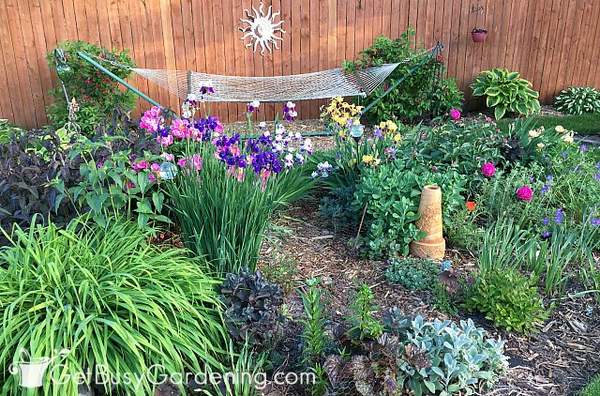
Also think about how a garden area might be affected once trees get their leaves in the spring. A full sun garden in the spring and fall could become pretty shady during the summer once the trees are full of leaves.
So it’s a good idea to measure garden sunlight during the peak summer months, as well is in the spring and the fall. That way you can see how the sun changes in your garden throughout the growing season.
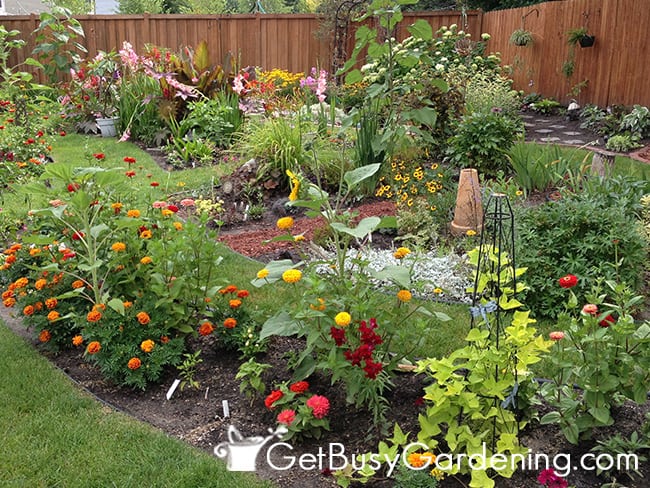
Once you know how to measure hours of sunlight in your garden, it’s easy to choose the right plants! Just be sure to map your garden sun exposure a few times throughout the year, and then again every few years as the landscape changes.
More Information About Garden Planning
- Perennials Made Easy! How To Create Amazing Gardens
- How To Design A Front Yard Foundation Planting
- Annual Flower Garden Design For Beginners
Share your tips for how to measure sun exposure in your garden in the comments section below.
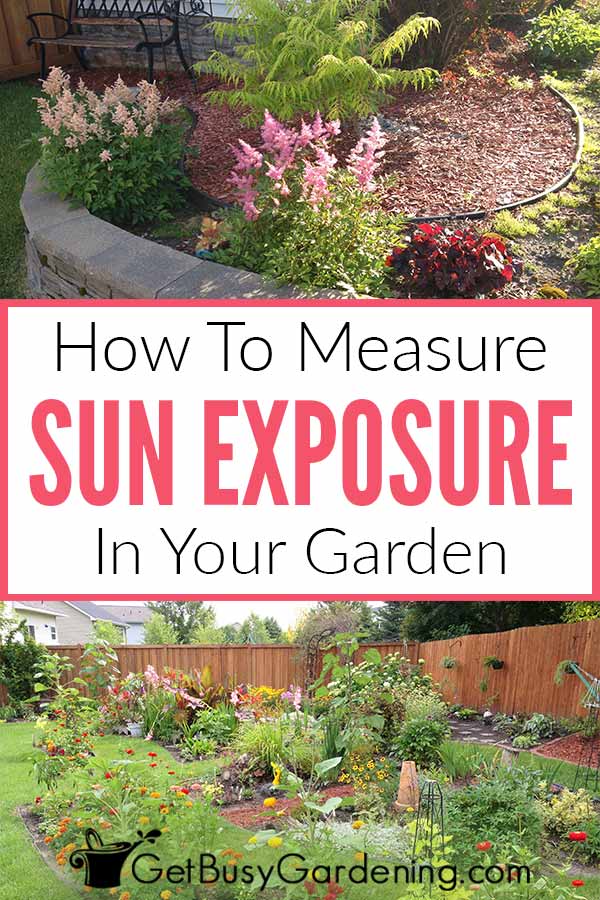
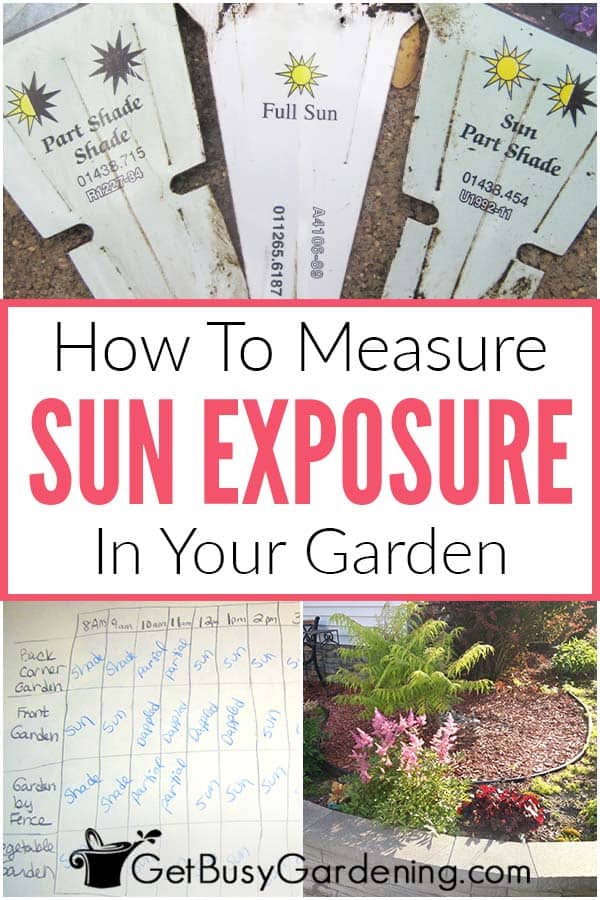
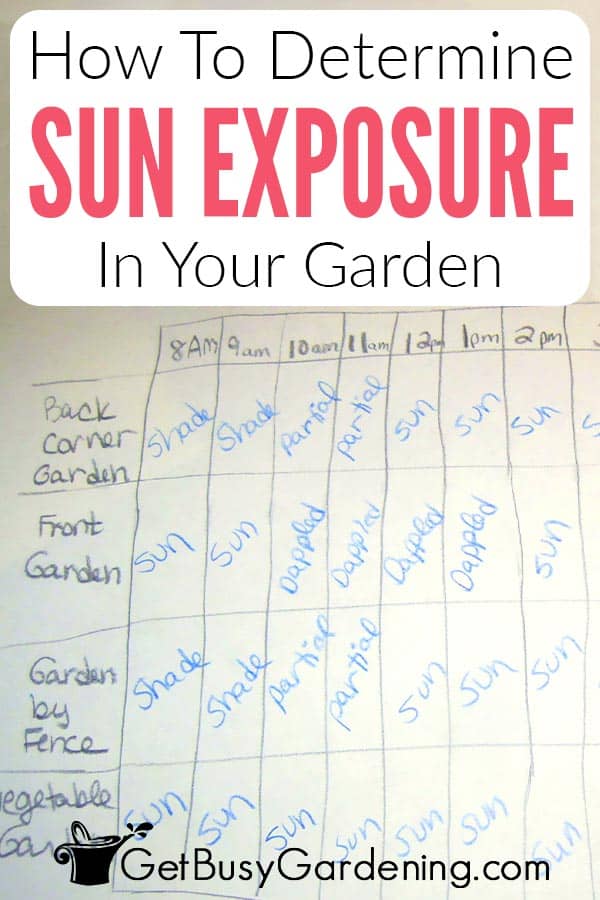
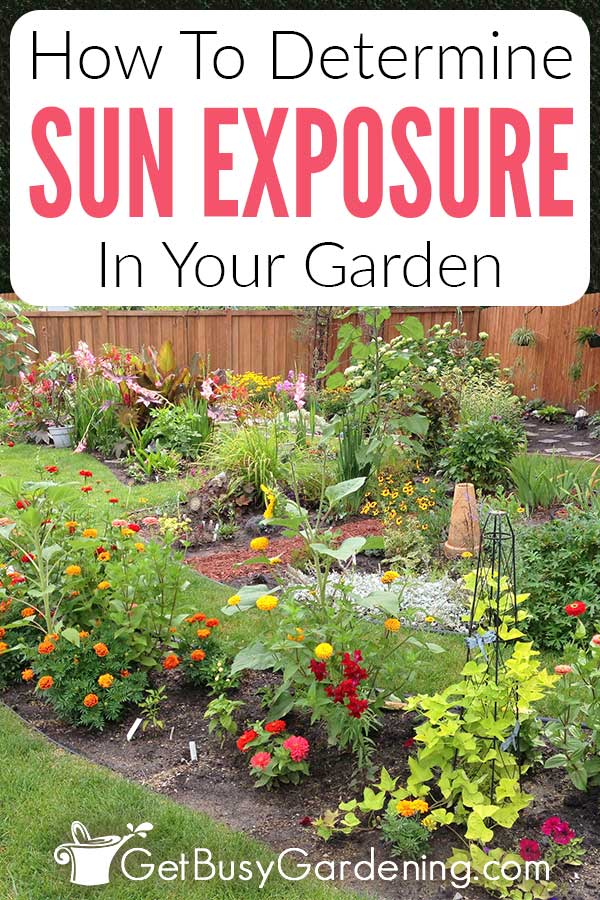
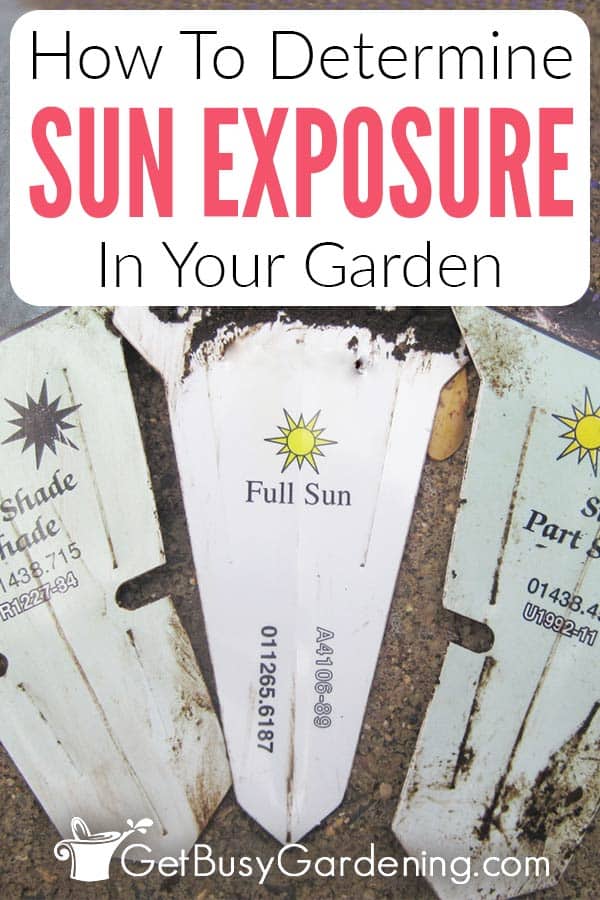
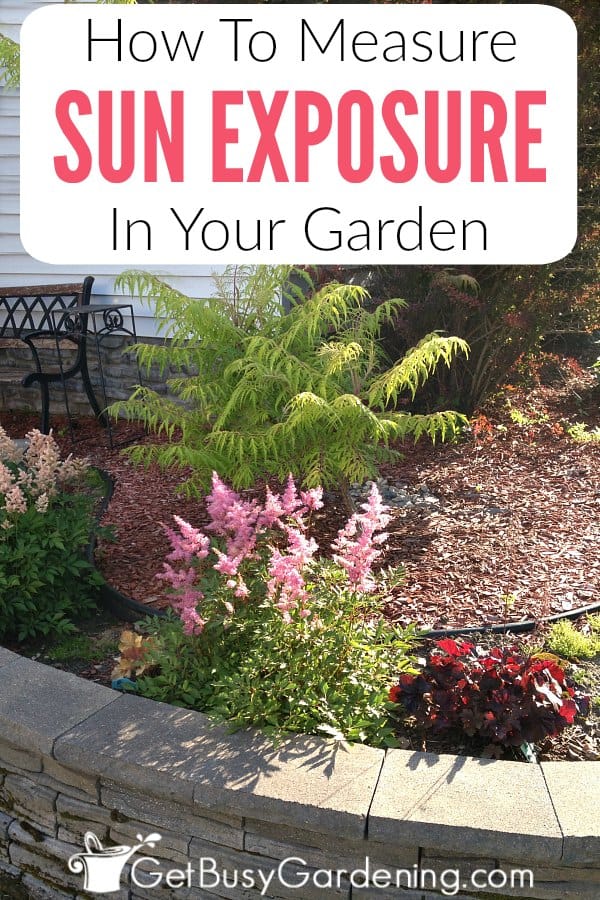


David says
The garden sunlight meter you linked to only gives a measurement of the amount of sunlight at the point in time you happen to be looking at it.
It doesn’t record the sunlight throughout the day or give you information that would let you know if an area has x hours of sunlight each day.
Amy Andrychowicz says
Yes, you’ll still have to create a chart as I show in the article to track the amount of sunlight in that garden area every hour. The gauge just makes it easier to tell the exact amount at any given time.
Alina Kodatt says
This was such an informative and thorough article! I don’t normally leave comments but wanted to just to say thank you!
Amy Andrychowicz says
You’re welcome, thanks for your nice comment. 🙂
Tricia Dikeman says
Great article!! I also live in zone 4b and I am planning to overhaul my gardens in the next few weeks. Is mid september too late to map my sunlight? I’m thinking that the sun is much lower in the sky and it won’t be accurate for the rest of the growing months. What do you think?
Amy Andrychowicz says
It’s a good idea to map out the sunlight a few times during the growing season. Spring, summer, and fall is great!
Heather says
Thank you for an excellent article!! Many of my questions answered in one place. Awesome!!
Amy Andrychowicz says
Wonderful, happy to hear I answered all of your garden sun exposure questions! You’re welcome. 🙂
Serena Williamson says
I have one of those 3 in 1 garden meters but it didn’t really have instructions. How do you use it to determine how much light exposure your plants are getting?
Amy Andrychowicz says
If you have the same light meter as I do, then there is a switch at the bottom where you can change it to be set to either moisture, pH or light. Move the switch to the middle to measure the light. Then place it in the spot where you want to measure the light. The needle should move pretty quickly to show you the light reading. It’s the top bar on the meter, the one that says “Dark” on one side and “Light” on the other, with some numbers under it. That’s the line you want to look at to determine sun exposure. Then you can move it around to the different areas of your garden, and also take readings throughout the day to see how it changes.
Melanie Klar says
Thank you! Good clarification! And if anyone else doesn’t have 1 full day to walk around noting shade and sun, I did it this week by writing on my calendar when I made note of it and spread it over a week so like Monday I did 9 a.m. 10 a.m. 3 and 5 on Tuesday I filled in some more on the hour times and filled it all in by the end of the week. I also took pictures of each area at each time because there are spots within each area that get more or less sun that would be hard to describe exactly where it is but when you see a picture it’s clear.
Amy Andrychowicz says
Wonderful! Thanks for adding your method for tracking the sun exposure in your gardens. Great ideas!
Lovely says
Hi, I loved your article! I was hoping you could answer a question about sun exposure requirements with fruit trees.
I’m a first time gardener, so I was wondering…When a fruit tree requires full sun, does that include early spring when it flowers? There’s plenty of sunlight in the area during the summer, but in the spring there’s only four or five hours. Any thoughts on this?
Amy Andrychowicz says
If the trees are growing just fine and producing fruit, then they’re fine. I think it would be more important for them to be in full sun during the months when they have leaves, since the leaves are what they use for photosynthesis, which generates the energy they need to produce flowers and fruit every year.
Vineta says
I really need to make a garden sun chart, multiple times a year. Seattle’s sun pattern changes dramatically with the seasons, and the plants that I thought would get very little sun are getting a lot more now that the sun is higher in the sky. Thanks for the great idea!
Amy Andrychowicz says
You’re welcome! Yes, I also make sure to measure the sunlight in my garden every few years as trees and other surrounding plants grow and mature.
RS says
Try the app findmyshadow it’s great
Amy Andrychowicz says
Awesome, thanks for the tip! I’ll have to check it out.
Mary Vidrine says
Thank you so much Amy! This puts on paper what I’ve been trying to sort out in my head. My question is similar to the last one. Hope this is not a super old post. My North facing front steps are in the shade right now. It seems to me the plants fried there last summer. So that would mean to me that the sun is further north in the winter.?? Is this correct?
Amy Andrychowicz says
Yes. Definitely measure hours of sunlight at different times during the year. If your shade plants are burning, the that area must get some sun during the middle of summer while the sun is high in the sky (and most intense).
seeingstone says
Will my garden get more sun in summer? I just moved in and I want to till, but I have tree lines on two sides and don’t know how much difference it might be in spring and summer.
Amy Andrychowicz says
The sun is more intense in the summer, and of course is up longer than it is in the fall/winter. So, we definitely get more sun during the summer. You also have to think about your surrounding trees – have any of them dropped their leaves? If so, those will create more shade when they are full of leaves in the summer. If you have an area in mind that is pretty open, and the tree leaf-out is not a problem, then it should be just fine.
Mike says
The sun moves higher in the sky towards the north in the summer. In the winter, the sun is low in the south in the northern hemisphere
Ashlie Milano says
Thanks for explaining this I was so confused. I don't think you could have made it any simpler. I appreciate it!
Amy Andrychowicz says
You're welcome, glad I could help.
Anonymous says
I'm in South Dakota and am working with a garden plot new to me. It has partial tree branch coverage. What is the earliest month, in your opinion, that I could do this?
Amy Andrychowicz says
Wait until the trees have fully leafed out before doing this in the spring. That will give you a pretty good feel for what the sun exposure of your garden will be through the summer. You could do it again at the peak of summer (June/July) to see how it differs, but I don't think you need to wait to plant stuff until then. Keep an eye on it through the summer and modify next year if necessary.
Amy
Amy Andrychowicz says
P.S. I reworded it so hopefully it makes more sense now. Let me know if it still sounds confusing, and thanks again for pointing that out!
Amy Andrychowicz says
RandomGardener – That's a really good point, and my wording is poor on that statement. What I was trying to say is that full sun plants should be in the sun during the peak hours of the day when the sun is at it's highest/hottest. Rather than being in full sun only during say 8am-10am and 4pm-8pm, with no full sun during the peak hours. I guess it's hard to explain. 🙂
Amy
Traci says
Perfect…that is EXACTLY what I needed to know! Thanks!
Amy Andrychowicz says
Wonderful! You’re welcome, glad I could help.
RandomGardener says
Good information! However, when I'm out in the yard, it feels hotter until about 6:30 pm in the summer, so does it not count towards full sun hours?